Dermatologists Say These Sunburn Home Remedies Will Heal Your Skin Fast
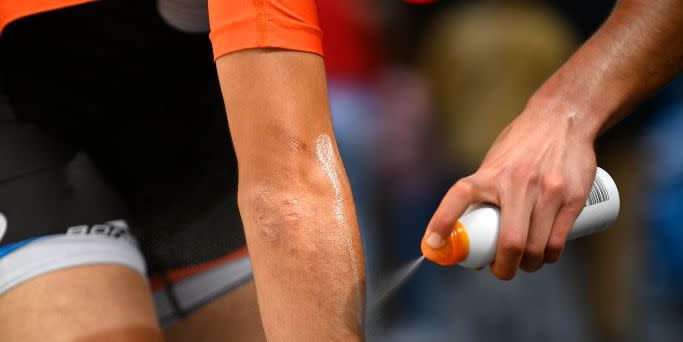
You know the drill: To prevent sunburn, you have to apply and reapply sunscreen not just on your rides, but any time you go outside. Not only does this keep your skin healthy, but more importantly, it minimizes your risk of skin cancer, such as basal and squamous cell carcinoma and melanoma.
But maybe you didn’t realize you missed a spot, your tube of sunscreen was expired, or your cycling cap and helmet didn’t protect you as well as you thought it would. Despite your best efforts, you’ve wound up with a lobster-red sunburn—and boy, is it painful, hot, and itchy.
Once you experience a burn, there’s not much you can do to reverse the long-term damage the sun’s ultraviolet (UV) rays have done to your skin. Still, board-certified dermatologists say there are steps you can take to soothe your sunburn and get relief in the moment. While prevention is key, treating sunburn with certain home remedies can help you feel better fast. You’ll encourage your skin to heal, tamp down the redness and pain, and learn the ultimate lesson: Don’t forget your sunscreen!
Here, the simple sunburn cures that actually work.
→ Get Bicycling All Access to stay on top of the latest health news!
Draw a sunburn-soothing bath

Skip the soap.
After a long day in the sun, the first thing you want to do is rinse off—but you should think twice before sudsing up. Soaking in a bubble bath and using soap can dry out and irritate sunburned skin. A cool bath (sans bubbles) is a better option.
If you must use soap while you wash, reach for something mild like Johnson’s Baby Head-to-Toe Wash and carefully rinse it all off—leftover soap residue can be extremely drying, which will only make your sunburn feel worse.
Soak in soothing oatmeal.
Another sunburn cure: Add oatmeal to your bath. Research shows colloidal oatmeal helps tamp down inflammation and reduces itching, says board-certified dermatologist Michael Schreiber, M.D., and you can find the ingredient in many Aveeno products, like their soothing bath treatment.
You can also simply grind up plain oats in your food processor and add to your tub. Mix the oatmeal treatment with cool bath water and soak for 15 to 20 minutes. Afterward, gently pat your skin dry with a clean towel. Rubbing your skin to dry off will only irritate it further.
Calm inflamed skin
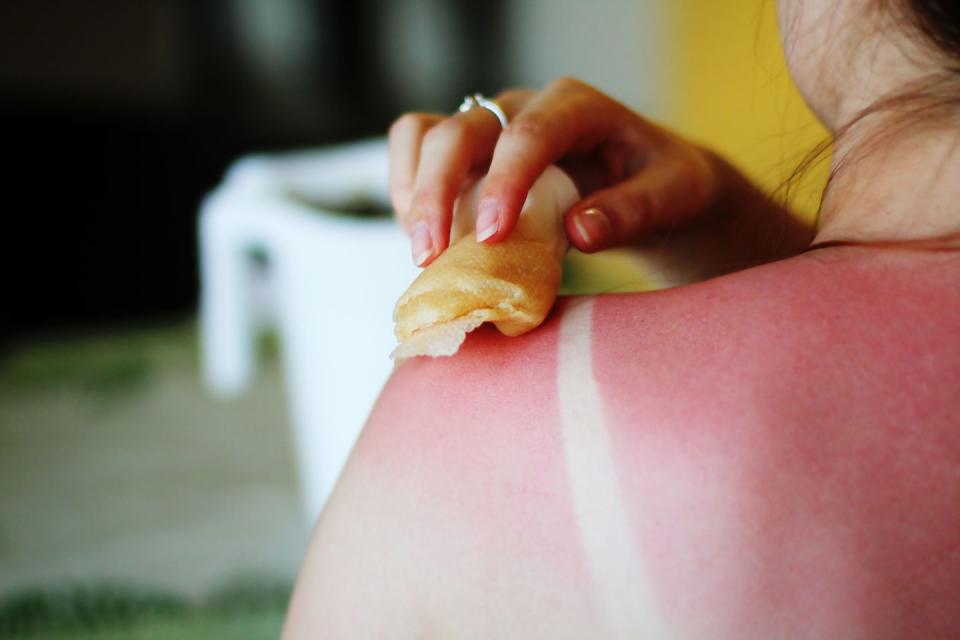
Reach for ice.
Follow your urge to reach for something cold, but make sure to do it right. Wrap an ice pack in a damp cloth and hold it over the burn. This will absorb some of the heat from your skin, constrict blood vessels, and reduce swelling.
Ice-cold water is also an option. Pour water and ice into a bowl, soak a cloth in the liquid, and place it over the burn. Repeat this process every few minutes as the cloth warms up. Apply the compress several times a day for 10 to 15 minutes for quick relief, Schreiber says.
...or frozen veggies.
Improvise, if necessary, says board-certified dermatologist Frederic Haberman, M.D., of Haberman Dermatology & Cosmetic Center in New York and New Jersey. “You could even take a bag of frozen peas, for instance, and use that. But make sure to wrap it first so that you’re not placing the icy package directly against your skin.”
Tame it with tea.
The tannic acid in green and black tea may help pull heat form a sunburn, while catechins (an antioxidant compound) repair skin damage, research shows. This can be particularly helpful if you’re burned around your sensitive eye area. Simply soak two tea bags in cool water and place them on top of closed eyes to decrease swelling and help relieve pain.
Stop the itch
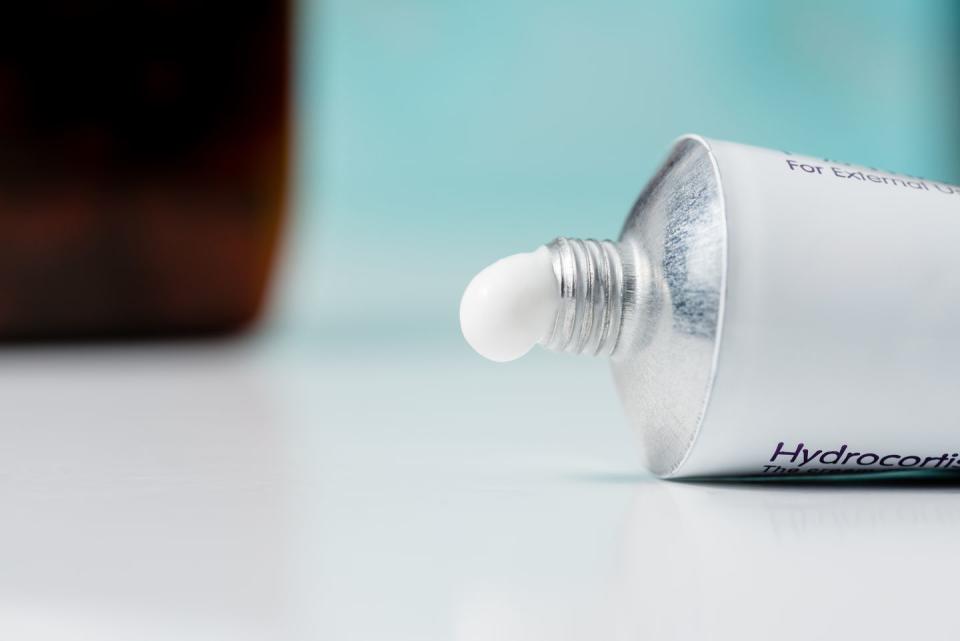
Use a rash-relieving powder.
If your burn becomes itchy, add a Domeboro Soothing Soak Rash Relief powder packet to your ice water compress, suggests Thomas Gossel, Ph.D., R.Ph., a professor of pharmacology and toxicology at Ohio Northern University. The aluminum acetate in the powder keeps skin from getting too dry or itchy.
Apply hydrocortisone cream.
Minimize itching, soothe skin irritation, and reduce inflammation with a topical lotion, spray, or ointment containing 1% hydrocortisone, such as Cortizone-10.
Hydrocortisone has anti-inflammatory properties, which means it will reduce redness and ease the pain of mild sunburns, says dermatologist Coyle S. Connolly, D.O., of Connolly Dermatology in New Jersey. “Use two or three times a day,” depending on the severity of your burn, he says.
Hydrate (and heal) dry skin
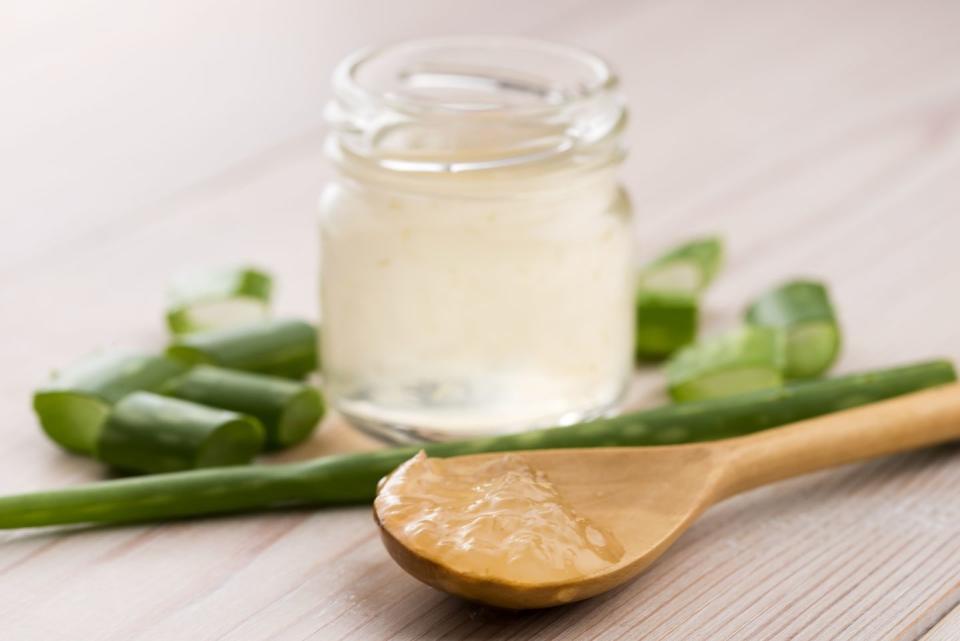
Load up on water.
You need to drink plenty of water to help counteract the drying effects of a sunburn, says Gossel. But if you can’t guzzle fast enough, snack on hydrating fruits and vegetables, such as watermelon, cucumber, strawberries, tomatoes, grapefruit, and cantaloupe—all of which are more than 90 percent water.
Moisturize strategically.
After you’ve rinsed off, smooth on a natural bath oil. Let it soak in for a minute, and then apply a moisturizing cream or lotion, such as Eucerin Skin Calming Lotion, to lock in hydration. This is an important step, says dermatologist Rodney Basler, M.D., or you may find that your skin feels drier than before. For added relief, chill your moisturizer in the fridge before applying. Avoid products that contain petroleum (like Vaseline) as they can trap in heat.
Slather on aloe vera.
This classic is the go-to sunburn cure for a reason. “We’re starting to see evidence in medical literature that aloe vera may really help wound healing,” says Basler. If you have an aloe plant, simply break off a leaf and apply the juice. Pure, organic aloe vera gel is the next best thing—especially if you chill it. Look for one that does not contain alcohol, colors, and fragrance that could further irritate the skin. (Check out the best aloe vera gel for your sunburn.)
Try coconut oil.
In a pinch, you can try using coconut oil on your sunburn—but not on a fresh one. Only use cold-pressed, organic coconut oil after any blistering has subsided and your burn has reached the end of its healing process (otherwise you may trap in heat, and you do not want that). Always test a patch of your skin first to ensure you don’t have any unwanted reactions. Avoid using coconut oil on your face if you are acne-prone, as it may clog pores and lead to breakouts.
Minimize pain and irritation
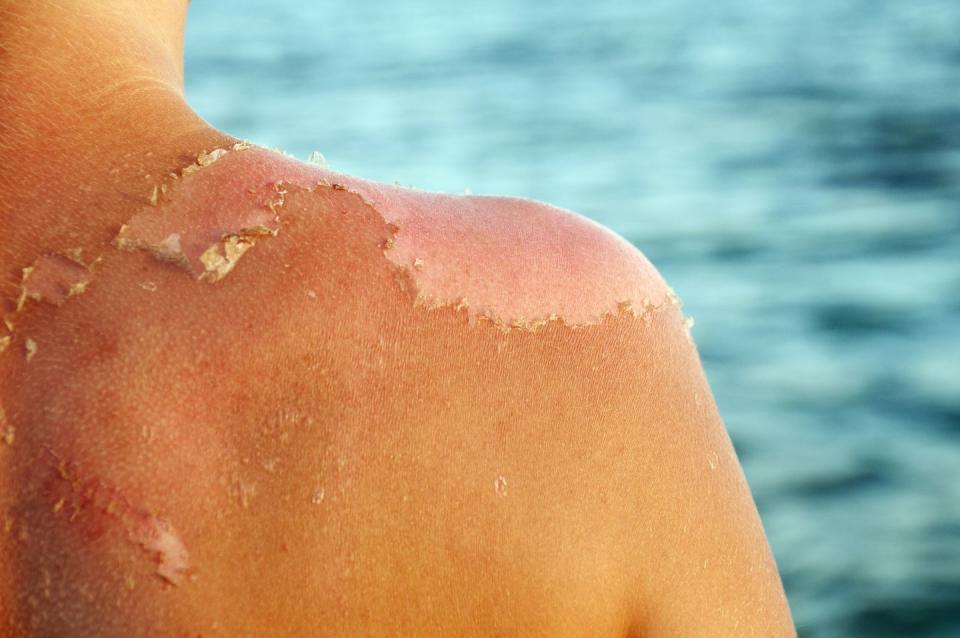
Blow up your air mattress.
Sleeping with a nasty sunburn can be challenging, but you need to rest for your body to recover. Try sprinkling talcum powder on your sheets to minimize chafing and friction, Haberman suggests. An air mattress might also help you sleep more easily since it retains less heat. Pro tip: If your legs or feet are burned, elevate your legs above heart level to help reduce swelling, Basler says.
Pop an aspirin.
This old standby can help relieve the pain, itching, and swelling of a mild to moderate burn. “Take two tablets every four hours,” says Basler. Acetaminophen and ibuprofen will work just as well; follow label instructions for dosages.
Avoid anything ending in -caine.
If your burn is mild, an OTC anesthetic might seem like a good idea, but you should avoid products that contain benzocaine or lidocaine, since they can irritate your skin, according to the American Academy of Dermatology (AAD).
Wear lightweight fabrics.
Wear soft, comfortable fabrics like cotton while your burn heals to minimize any painful rubbing that could further irritate your skin.
Resist the urge to peel.
Blisters are a sign of severe damage, and they must be treated with care. If they bother you and they cover only a small area, you may carefully drain them, Basler says. However, do not peel the top skin off; you’ll have less discomfort and danger of infection if air does not come in contact with sensitive nerve endings.
To drain the fluid, first, sterilize a needle by holding it over a flame. Then puncture the edge of the blister and press gently on the top to let the fluid come out.
Do this three times in the first 24 hours, and then leave the blisters alone, says Basler. When in doubt, see your dermatologist if you think your sunburn peeling may have signs of infection, like excessive swelling or pus.
Protect your burn.
You don’t want to do anything that will make your sunburn worse. So ideally, you want to avoid UV rays while your skin heals. But if you must head outdoors, be sure to wear protective clothing and sunscreen with an SPF 30 or higher. Tightly woven fabrics work best here, so when you hold your shirt up to a bright light, you shouldn’t see it shining through, the AAD says.
How to prevent sunburn
While these sunburn cures can help, don’t make the same mistake twice. After your burn, it takes three to six months for your skin to return to normal, Schreiber says. “When you get a sunburn, and the top layer of skin peels off, the newly exposed skin is more sensitive than ever. That means you’ll burn even faster than you did before if you’re not careful.”
Be aware of your sun exposure and protect yourself by applying sunscreen. Look for a broad-spectrum formula with a minimum of SPF 30, ideally with a strong physical blocker like zinc oxide or titanium dioxide, says Norman Levine, M.D., a dermatologist in Tucson, Arizona.
Apply sunblock liberally about 30 minutes before heading outside, even when it’s overcast, and don’t forget to protect your lips, hands, ears, and the back of your neck. Reapply every two hours. Wearing protective clothing like hats, lightweight long-sleeved tees, and cover-ups can also help to keep your skin protected.
When should you call a doctor for sunburn relief?
Some burns are simply too severe to be treated at home, says Basler. Consult a doctor if you experience nausea, chills, fever, faintness, extensive blistering, general weakness, patches of purple discoloration, or intense itching. Be aware that if the burn seems to be spreading, you could have an infection compounding the problem.
You should also contact your physician if you’re taking prescription medications. Certain drugs, like antibiotics, tranquilizers, and antifungal medications can increase your sensitivity to the sun and cause reactions, says Basler. Oral contraceptives, diuretics, drugs for diabetes, and even PABA-containing sunscreens may also increase your risk of sunburn.
This article was medically reviewed by board-certified dermatologist Mona Gohara, M.D.
You Might Also Like

